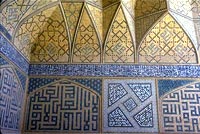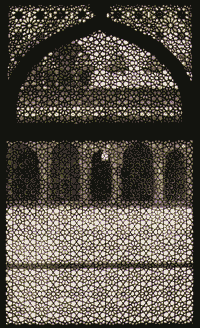

|
|
Science, Art and Society
By Muzaffar Iqbal
|
 |
Harmoniously embedded in the seven-sided prayer niche of the Córdoba Mosque are many features of various Islamic sciences, arts, architectural motifs and a peculiar Islamic usage of colors and forms. This blend creates a unique space inside the niche—where the word of God was once recited—a space that evokes the feeling of awe and reminds one of the mysterious “niche of light” passage in the celebrated “Light Verse” of the Qur’an (24:35). The fluted shell-like vault, designed to create extraordinary acoustics for the transmission of the recitation of the Qur’an to the far corners of the mosque, and the horseshoe shaped arch that seems to breathe “as if expanding with a surfeit of inner beatitude, while the rectangular frame enclosing it acts as a counterbalance. The radiating energy and the perfect stillness from an unsurpassable equilibrium.” 5
It is no wonder that this extraordinary mosque has remained, up to our own times, one of the enduring sources of inspiration and reflection on that period of Islamic civilization that had nurtured a scientific tradition which seamlessly blended its various connections with the metaphysical sources of Islam. Seen in its totality, Islamic scientific tradition is not only rooted in the metaphysical truths of Islam, it is also integrally linked to Islamic art, Arabic language and literature and all other expressions of human creativity that emerged within Islamic civilization. It is this integral aspect of the nexus between Islam and the science it inspired that was to be lost through the implantation of modern Western science in the Muslim world. But before modern science could come into existence, a large body of Islamic tradition had to be transmitted to Europe. This process of transmission, and the subsequent transformation of this material forms another link in the emergence of a new Islam and science discourse and is explored in chapter 6. The next chapter is, however, devoted to an examination of a question that has vexed several generations of historians: the withering of Islamic scientific tradition.
Excerpted from Islam and Science, Ashgate, 2002. .
1. Eaton, Charles Le Gai (2000), Remembering God: Reflections
on Islam, ABC International Group, Inc, Chicago, pp. 55-6.
2. Nasr, Seyyed Hossein (1987), Islamic Art and Spirituality, State
University Press of New York, Albany, p. 47.
3. Burchardt, Titus (1999), Moorish Culture in Spain, tr. by Alisa
Jaffa and William Stoddart, Fons Vitae, Louisville, pp. 9-10.
4. Burchardt (1999), p. 11.
5. Ibid.
ISLAM AND SCIENCE
Islam and Science provides the necessary background for
understanding the contemporary relationship between Islam and modern
science. Presenting an authentic discourse on the Islamic understanding
of the physical cosmos, Muzaffar Iqbal explores God’s relationship
to the created world and the historical and cultural forces that
have shaped and defined Muslim attitudes toward science. What was
Islamic in the Islamic scientific tradition? How was it rooted in
the Qur’anic worldview and whatever happened to it? These
are some of the facets of this rich and fascinating account of a
tradition that spans eight centuries and covers a vast geographical
region.
Written from within, this ground-breaking exploration of some of
the most fundamental questions in the Islam and science discourse
explores the process of appropriation and transformation of the
Islamic scientific tradition in Europe during the three centuries
leading up to the Scientific Revolution. The book can be ordered
from www.amazon.com
or www.Ashgate.com
Muzaffar Iqbal: A Biographical Note
Dr. Muzaffar Iqbal is the founder-president of Center for Islam and Science (CIS), Canada. He holds a Ph.D. in Chemistry from the University of Saskatchewan, Canada (1983). He did his post-doctoral work at the Montreal Neurological Institute of the McGill University where he synthesized radioactive tracer medicines for tracing brain tumours.
Dr. Iqbal has held academic and research positions at University
of Wisconsin-Madison (1984-85), McGill (1986) and University of
Saskatchewan (1979-1984). During 1990-1999, he lived and worked
in Pakistan, first as Director (Scientific Information) for the
Organization of Islamic Conference (OIC) Committee on Scientific
and Technological Cooperation (COMSTECH) and later as Director (International
Cooperation), Pakistan Academy of Sciences (PAS). COMSTECH is the
main scientific body of the 56 Muslim States of OIC. He was thus
directly involved with the development of scientific institutions
in the Muslim world.
Dr. Iqbal was the editor of Islamic Thought and Scientific Creativity
(1991-96)—an international journal in the field of Islam and
science.
His published works include Science in Islamic Polity in the Twenty-first
Century (ed., 1995), Health and Medical Profile of the Muslim World
(ed., 1993), Possible Strategy for Energy Mixes in the Muslim World
(Co-ed., 1994), Mineral Profile of the Muslim World (ed., 1995).
He was the Guest Editor for the Winter 2000 special issue (on Islam
and Science) of Islamic Studies, the quarterly journal of the Islamic
Research Institute, International Islamic University, Islamabad,
Pakistan.
Dr. Iqbal has published papers on the history of philosophy of science,
history of Islamic science and on the relationship between Islam
and science in various international journals. He is also the author
of two novels, Inkhilac (Uprooting, 1988) and Inqtac (Severance,
1994), a book on the history of the Independence Movement of Pakistan
(1977), a book on the life and works of Herman Melville (Herman
Melville: Life and Works, Savera, 1996) and more than fifty short
stories. His fiction and translations have appeared in literary
journals in Pakistan, Canada and the United States.
His other publications include a bilingual (Arabic-Urdu) edition
of the poetry of the tenth century mystic, Mansur al-Hallaj, Divan
al-Hallaj (1997, reprinted 2000), an anthology of Pakistani short
stories, Colours of Loneliness (Oxford University Press, 1999) and
Towards Understanding the Qur’an, (tr.) ( Leicester, 2000).
Dr. Iqbal’s areas of specialization include intellectual history
of Islam, metaphysical and philosophical aspects of the relationship
between Islam and science, Islam and the West and Islam and the
contemporary world.
Dr. Iqbal is the editor of Kalam www.kalam.org,
an edited and moderated listserver and news service dedicated to
the promotion of a constructive discourse on Islam and science.
His fortnightly column, “Quantum Note”, appears on every
second Friday in Pakistan’s largest English language newspaper,
The News, http://www.jang-group.com/thenews.
His forthcoming publications include Islam and Science (Ashgate,
2002) and God, Life & the Cosmos: Christian and Islamic Perspectives
(co-ed.) (Ashgate, 2002).
